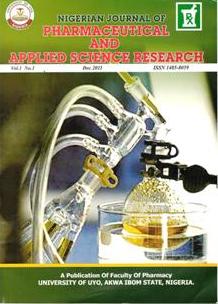Pharmacognostic Studies of Pseuderanthemum Carruthersii (Seem.) Guillaumin (Acanthaceae) Leaf
Main Article Content
Abstract
Background: Pseuderanthemum Carruthersii (Acanthaceae) is traditionally utilized in the treatment of stomach, lung, and liver cancers. This study evaluated the pharmacognostic and physicochemical properties of the leaves to establish quality control parameters.
Methods: Fresh leaves of P. carruthersii were collected, authenticated, air-dried, pulverized, and stored in glass containers. Standardized procedures were employed to assess microscopy, micromeritic properties, chemomicroscopy, fluorescence characteristics, soluble extractive values, moisture content, ash values, and gas chromatography-mass spectrometry (GC-MS) analysis of the dichloromethane leaf extract.
Results: Microscopic analysis revealed the presence of hypostomatic stomata. Micromeritic evaluation indicated an angle of repose of 35.49°, Carr's Index of 34.83%, and Hausner's ratio of 1.53. The water-soluble, ethanol-soluble, and methanol-soluble extractive values were determined as 19.3% w/w, 9.0% w/w, and 10.0% w/w, respectively. Fluorescence analysis exhibited varied coloration, suggesting the presence of diverse phytochemicals. The moisture content, total ash, acid-insoluble ash, and water-soluble ash values were: 12.67% w/w, 19.8% w/w, 1.3% w/w, and 5.8% w/w, respectively. Chemomicroscopic examination of the powdered leaf confirmed the presence of mucilage, lignin, starch, cellulose, and protein.
GC-MS analysis identified a total of nine phytochemicals, with five major components exhibiting prominent peaks: Octadecahydro-benzo[cd]pyrene (25.42%), Cyclopropaneoctanoic acid (11.51%), 1-Phenanthrenecarboxylic acid (11.40%), Ethyl iso-allocholate (11.07%), and Cis-11-Hexadecenal (10.48%). Minor constituents included Rhodopin (6.07%), Butyrolactone (7.31%), Hydroxyacetic acid (7.33%), and 9-Octadecene, 1-methoxy- (E) (9.37%).
Conclusion: This study provided essential quality control benchmarks for the authentication of fresh and powdered leaf preparations of P. carruthersii. These findings contribute to the standardization of herbal formulations derived from this medicinal plant.
Downloads
Article Details

This work is licensed under a Creative Commons Attribution-NonCommercial-NoDerivatives 4.0 International License.
References
Vo HB, Berit SP, Le Van T, Andreas K, Tat CT, Christian, WW, Suthajini Y, Thomas H. Neutral Polysaccharide from the Leaves of Pseuderanthemum carruthersii: Presence of 3-O-Methyl Galactose and Anti-Inflammatory Activity in LPS-Stimulated RAW 264.7 Cells. Polymers (Basel) 2019: 11(7):12-19
Sharma A, Kumar A. Acanthaceae: Taxonomy and uses in traditional medicinal system. World Journal of Pharmaceutical Research, 2016, 5(7):403-412.
Thi NV, Minh H, Kim PP. Nitrogen-Containing Compounds from Pseuderanthemum carruthersii var. Atropurpureum. Journal of Technical Education Science, 2018: 33-36.
Angiosperm Phylogeny Group. An update of the Angiosperm Phylogeny Group classification for the orders and families of flowering plants: APG IV. Botanical Journal of the Linnean Society, 2016: 181(91): 1-20.
Killedar GS, Harianth N, Sameer J, Nadaf S, Karade R. Phytochemical potential ofMemecyclon umbellatum. Burm. Leaf extracts. Journal of Drug Delivery and Therapeutics, 2014: 4(2): 30-35.
Johnny II, Umoh UF, Umoh R A, Alozie MF, Udobre AS, Igboasoiyi AC, Bassey ME, Andy NA, Udo IJ, Umoh OT. Pharmacognostic Characterization of Cola millenii K. Schum. (Malvaceae). Asian Journal of Biology, 2022: 14(1): 6-24.
African pharmacopoeia. General methods of Analysis Pharmacopoeia.,1986: 11:121-208
Mbah CC, Builders PF, Akuodor GC, Kunle OO. Pharmaceutical characterization of BrideliaferrugineaBenth (Euphorbiaceae). Tropical Journal of Pharmaceutical Research, 2012: 11(4): 637- 644.
Trease GE, Evans WC. Pharmacognosy. Elserviers Ltd., United Kingdom, 2009: 16:560 - 570.
Kokate CK, Purohit AP, Gokhale SB. Analytical Pharmacognosy, Nirali publication. 2005: 30:199.
Khandelwal KR. Practical pharmacognosy techniques and experiments. New Delhi: NiraliPrakashan., 2002: 15 – 163.
Kumar D, Gupta J, Kumar S, Arya R, Kumar, T, Gupta G. Pharmacognostic evaluation of Cayratia trifolia (Linn.) leaf. Asian Pacific Journal of Tropical Biomedicine, 2012: 2(1): 6 – 10.
Perveen A, Abid R, Fatima R. Stomatal Types of Some Dicots within Flora of Karachi, Pakistan. Pakistan Journal of Botany, 2007: 39(4):1017-1023.
Hanif M, Shoaib, MH, Yousuf, RI, Sattar S, Nadeem M, Hussain L, Zia MU, Muhammad IN, Üzair M, Qadir I. Formulation Development of Intermediate Release of Nimesulide Tablets by CCRD for IVIVC Studies. Pakistan Journal of Pharmaceutical Sciences, 2014: 27(4):785-792.
Romanus AU, Uwemedimo FU, Imoh IJ, Omodot TU, Victor UA, Anwanabasi EU, Akwaowoh AE, Moses AA Etido AM. Phytopharmacognostic Evaluation of the Leaves of Gnetum africanum Welw (Gnetaceae). Journal of Complementary and Alternative Medical Research, 2020: 11(3): 32-41.
Kasthuri OR, Ramesh B. Physiochemical and fluorescence Analysis of Leaves of Alternanthera brasiliana (L.) Kuntze and Alternanthera bettzickiana (Reege) Voss. International Journal of Pharmaceutic Science Reviews and Research, 2018: 51(1):11, 66-71.
European Pharmacopoeia. Pharmacopoeial Limits of Crude Drugs. Strabourg: Council of Europe, 2007: 6: 124-164.
Kornhauser A, Wei R, Yamaguchi Y, Coelho SG, Kaidbay K, Barton C, Takahashi K, Beer JZ, Miller SA, Hearing VJ. The Effects of Topically Applied Glycolic Acid and Salicylic Acid on Ultraviolet Radiation-Induced Erythema, DNA Damage and Sunburn Cell Formation in Human Skin. Compound Newsletter, 2009: 55(1):10-17.
Costa JP, Ferreira PB, De Sousa DP, Jordan J, Freitas RM. Anticonvulsant Effect of Phytol in a Pilocarpine Model in mice.Neuroscience Letters, 2012: 523(2):115-118.
Hur J, Jan J, Sim JA. Review of the Pharmacological Activities and Recent Synthetic Advances of ?-Butyrolactones. 2021: 22(5):2769.
National Center for Biotechnology Information NCBI. PubChem Compound Summary for CID 984, Hexadecanal: https://pubchem.ncbi.nlm.nih.gov/compound/Hexadecanal. 2023.
National Center for Biotechnology Information. PubChem Compound Summary for CID 49998: https://pubchem.ncbi.nlm.nih.gov/compound/49998. 2023.
Krishnanunni K, Senthilvel P, Ramaiah S, Anbarasu A. Study of chemical composition and volatile compounds along with in vitro assay of antioxidant activity of two medicinal rice varieties: Karungkuravai and mappilai samba. 2015: 52: (25)72-84.
Sakmar TP, Huber T. Encyclopedia of Neuroscience. International Journal of Research in Ayuverda and Pharmacy, 2009: 302-310.
Cideciyan AV, Jacobson SG, Beltran WA. Rod function deficit in retained photoreceptors of patients with class B Rhodopsin mutations. 2005: Sci Rep 10, 12552.
Xiong B, Bellen HJ. Rhodopsin homeostasis and retinal degeneration: lessons from the fly. 2013: 650-660.
Karanja LN, K’Owino IO, Wangila PT, Ramkat RC. Asian Journal of Applied Chemistry Research. 2021: 9(4):1-16


